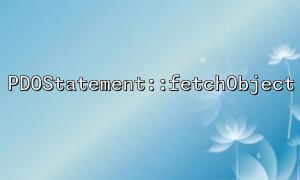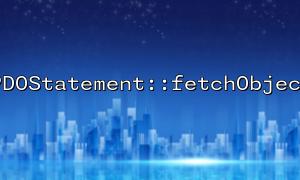In PHP, PDO (PHP Data Objects) provides a flexible way to access databases. PDOStatement is a very powerful class that provides multiple ways to handle query results. fetchObject and fetchColumn are two commonly used functions, which are used to obtain different types of database results. This article will explain in detail how to use PDOStatement::fetchObject and PDOStatement::fetchColumn in PHP and provide detailed examples.
The fetchObject method returns a row of data from the database query result as an object. The return value of this method is a class instance, and each field corresponds to the attributes of the class. Column values in the database can be accessed through the properties of the object.
// Sample code
$pdo = new PDO('mysql:host=localhost;dbname=testdb', 'root', 'password');
$query = $pdo->query('SELECT id, name FROM users');
while ($user = $query->fetchObject()) {
echo "User ID: " . $user->id . "<br>";
echo "User Name: " . $user->name . "<br>";
}
The fetchColumn method is used to obtain a column value of a query result, usually returning a single value, such as the result of a single column query or aggregate query.
// Sample code
$pdo = new PDO('mysql:host=localhost;dbname=testdb', 'root', 'password');
$query = $pdo->query('SELECT COUNT(*) FROM users');
$count = $query->fetchColumn();
echo "Number of users: " . $count;
While fetchObject and fetchColumn are usually used in different scenarios, we may sometimes need to use them in combination. For example, we might need to get records in a table and also get individual values for certain columns of that record. Using these two methods together allows us to flexibly handle complex query requirements.
Suppose we have a users table with id , name and age fields. We want to get the names and ages of all users from the database, and we also need to calculate the sum of ages of all users. We can use fetchObject to obtain user information and use fetchColumn to calculate the sum of age.
// Sample code
$pdo = new PDO('mysql:host=localhost;dbname=testdb', 'root', 'password');
// Get user information
$query = $pdo->query('SELECT id, name, age FROM users');
while ($user = $query->fetchObject()) {
echo "User ID: " . $user->id . "<br>";
echo "User Name: " . $user->name . "<br>";
}
// Calculate the sum of age
$query = $pdo->query('SELECT SUM(age) FROM users');
$totalAge = $query->fetchColumn();
echo "Total age of all users: " . $totalAge;
In some cases, we may want to get both column data and object data from the same query. This scenario can be achieved through the combination of fetchColumn and fetchObject . First, we get the required columns and then use fetchObject to get the details.
// Sample code
$pdo = new PDO('mysql:host=localhost;dbname=testdb', 'root', 'password');
// Get user information和某个字段
$query = $pdo->query('SELECT id, name, age FROM users');
while ($user = $query->fetchObject()) {
echo "User ID: " . $user->id . "<br>";
echo "User Name: " . $user->name . "<br>";
// usefetchColumnTo get a specific column,Such as age
$age = $pdo->query("SELECT age FROM users WHERE id = $user->id")->fetchColumn();
echo "User Age: " . $age . "<br>";
}
In PHP, PDOStatement::fetchObject and PDOStatement::fetchColumn are two very commonly used methods, and they are each suitable for different scenarios. When we need to process object data and certain column values at the same time, we can use these two methods in conjunction to achieve efficient data processing. Through the above example, we understand how to extract object and column data in a query, thereby achieving more flexible database operations.
Related Tags:
PDOStatement













